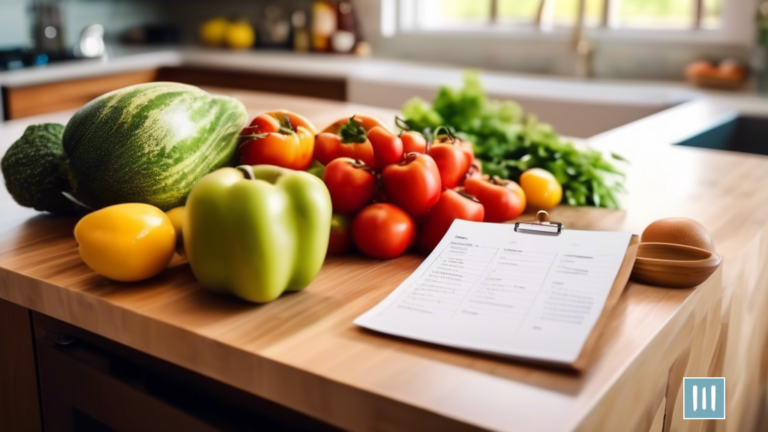Are you tired of constantly feeling overwhelmed by meal planning and grocery shopping? Do you find yourself struggling to stay organized and on track with your dietary needs? Well, fret not, because there is a solution to simplify your meal planning process – creating a comprehensive grocery list. By following a few simple steps and utilizing a well-organized shopping list, you can take the stress out of meal planning and ensure that you have everything you need to create delicious and nutritious meals throughout the week.
With a comprehensive grocery list in hand, you can streamline your meal planning process and make your trips to the grocery store more efficient. By assessing your dietary needs, creating a weekly meal plan, and organizing your shopping list accordingly, you can save time and money while ensuring that you have all the ingredients you need on hand.
So, whether you’re a busy parent trying to feed your family healthy meals, a college student looking to eat better on a budget, or simply someone who wants to make meal planning easier, a comprehensive grocery list is the key to simplifying your meal planning and making your life a little bit easier.
Key Takeaways
- Create a comprehensive grocery list to streamline your shopping experience
- Organize your shopping list by categorizing items to save time in the store
- Tailor your grocery list to meet your nutritional requirements and dietary needs
- Implement a weekly meal plan to stay organized and make grocery shopping easier
Assessing Your Dietary Needs
By assessing your dietary needs, you’ll be able to tailor your grocery list to ensure you’re meeting all your nutritional requirements. Take a moment to reflect on what your body needs to function at its best. Consider any dietary restrictions or preferences you have, as well as any health goals you’re working towards. Maybe you need to increase your intake of fruits and vegetables, or perhaps you’re trying to cut back on processed foods. Understanding your unique dietary needs will help you create a grocery list that supports your overall well-being.
Once you have a clear picture of your dietary needs, it’s time to turn that knowledge into a practical grocery list. Think about the different food groups you need to include in your meals and snacks, such as protein, carbohydrates, fats, vitamins, and minerals. Make a list of specific items that will help you meet those needs, like lean proteins, whole grains, fresh produce, and healthy fats. By taking the time to assess your dietary needs and create a comprehensive grocery list, you’ll set yourself up for success in simplifying your meal planning and making sure you have everything you need to nourish your body.
Creating a Weekly Meal Plan
Planning out your weekly meals can help you stay organized and make grocery shopping easier. Start by considering your schedule for the week and how much time you have to prepare meals. Take note of any special events or occasions that may impact your meal planning. Once you have a general idea of your week ahead, begin to outline what meals you want to make for breakfast, lunch, and dinner.
When creating your weekly meal plan, think about incorporating a variety of foods to ensure you’re getting a balanced diet. Include different proteins, vegetables, fruits, and grains to keep your meals interesting and nutritious. Don’t forget to take into account any dietary restrictions or preferences you may have. By taking the time to plan out your meals for the week, you can save time and stress when it comes to deciding what to eat each day.
Organizing Your Shopping List
Get organized and make shopping easier by categorizing the items on your shopping list. When you group similar items together, you’ll streamline your trip to the store and save time wandering aisles.
Here’s how to organize your shopping list like a pro:
- Produce: Start your list with fruits and vegetables to ensure you’re getting your daily nutrients.
- Dairy and Eggs: Next, list dairy products and eggs to keep your fridge stocked for breakfast and baking needs.
- Meat and Proteins: Include meat, poultry, and plant-based proteins for balanced meals throughout the week.
- Pantry Staples: Finish off your list with pantry staples like grains, canned goods, and spices to round out your meals.
By organizing your shopping list in this way, you’ll not only save time at the store but also ensure you have all the ingredients you need to prepare your meals for the week. Your future self will thank you for making meal planning and grocery shopping a breeze.
Shopping for Ingredients Efficiently
Effortlessly streamline your ingredient shopping for efficient meal prep. By strategically organizing your shopping list and grouping ingredients together, you can save time and energy at the grocery store. Consider dividing your list into categories such as produce, dairy, and pantry items to make navigating the aisles a breeze. With a well-organized list in hand, you’ll be able to quickly locate the items you need and avoid unnecessary backtracking.
To further optimize your shopping experience, consider planning your route through the store based on the layout. Start with the perishable items that require refrigeration or freezing, then move on to the non-perishable items. This approach will help keep your groceries fresh and reduce the risk of forgetting key ingredients. Additionally, take advantage of any digital tools or apps that can help you create a detailed shopping list and even provide you with aisle locations for specific items. By implementing these simple strategies, you can efficiently shop for ingredients and make meal prep a seamless and enjoyable experience.
| Category | Items | Quantity |
|---|---|---|
| Produce | Tomatoes, Avocado | 2 |
| Dairy | Milk, Cheese | 1 gallon |
| Pantry | Pasta, Rice, Spices | 3 boxes |
Meal Prep and Storage Tips
Maximize your meal prep efficiency with smart storage tips to keep your food fresh longer. When prepping your meals, consider using airtight containers to store chopped vegetables, cooked grains, and marinated proteins. This not only saves you time during the week but also ensures your ingredients stay fresh and flavorful.
Labeling your containers with the date and contents can help you stay organized and avoid any food waste. Another tip for efficient meal prep is to divide larger portions into individual servings before storing them in the fridge or freezer. This makes it easy to grab a ready-to-eat meal when you’re short on time or don’t feel like cooking.
Additionally, investing in quality storage bags and reusable containers can help reduce plastic waste and keep your food fresh longer. By implementing these storage tips, you can streamline your meal prep process and enjoy delicious, homemade meals throughout the week.
Frequently Asked Questions
How can I incorporate more variety and creativity into my meal planning without adding too much complexity?
Looking to spice up your meal planning without the extra hassle? Get inspired by trying new recipes from different cuisines, incorporating seasonal produce, and experimenting with various herbs and spices for a delicious twist!
Are there any specific tools or apps that can help streamline the process of creating a comprehensive grocery list?
To streamline creating a comprehensive grocery list, try using apps like AnyList or Out of Milk. These tools allow you to easily add items, categorize them, and even share lists with others for a more organized shopping experience.
How can I adjust my meal planning and grocery list for specific dietary restrictions or preferences, such as gluten-free or vegan diets?
Adjusting your meal planning for dietary restrictions or preferences like gluten-free or vegan diets is simple. Juxtapose your usual ingredients with suitable alternatives, such as gluten-free pasta or tofu for meat. Serve yourself and others with delicious, tailored meals.
What are some tips for avoiding food waste and using up all the ingredients on my grocery list?
To avoid food waste and use up all ingredients, plan meals that incorporate similar ingredients, freeze leftovers for later, and get creative with recipe substitutions. Embrace the challenge of using everything on your grocery list!
How can I save money on groceries while still maintaining a well-rounded and nutritious meal plan?
To save money on groceries while maintaining a balanced meal plan, shop sales, buy in bulk, and prioritize seasonal produce. Stretch your dollar further by meal prepping, cooking at home, and embracing creativity in the kitchen.

















